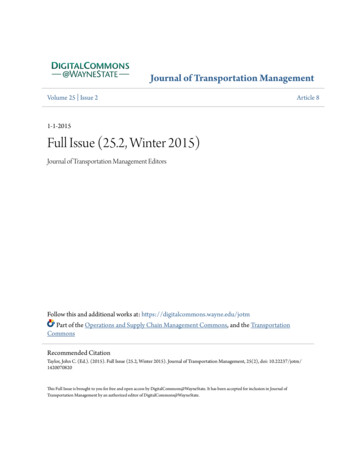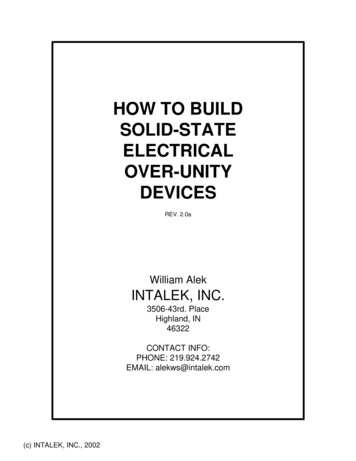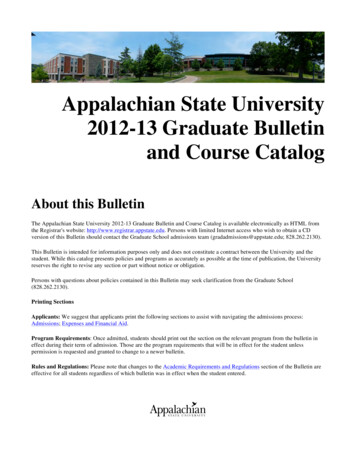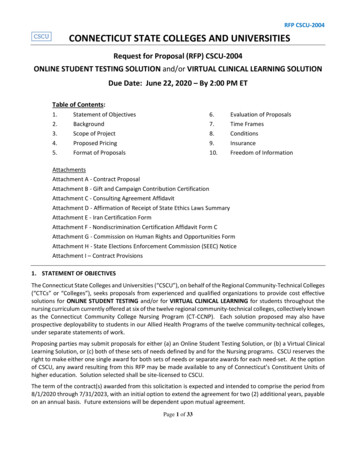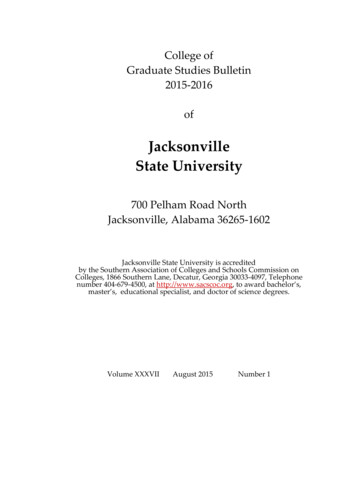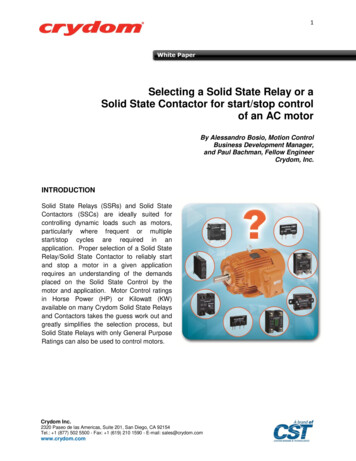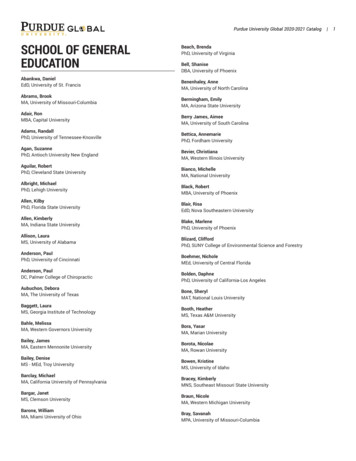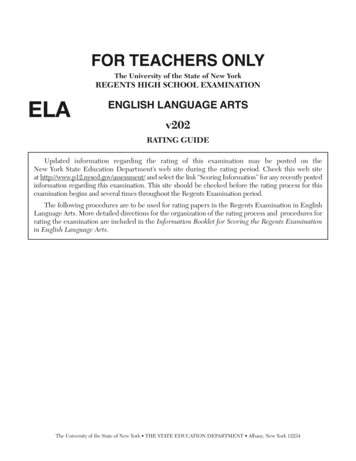
Transcription
FOR TEACHERS ONLYThe University of the State of New YorkREGENTS HIGH SCHOOL EXAMINATIONELAENGLISH LANGUAGE ARTSv202RATING GUIDEUpdated information regarding the rating of this examination may be posted on theNew York State Education Department’s web site during the rating period. Check this web siteat http://www.p12.nysed.gov/assessment/ and select the link “Scoring Information” for any recently postedinformation regarding this examination. This site should be checked before the rating process for thisexamination begins and several times throughout the Regents Examination period.The following procedures are to be used for rating papers in the Regents Examination in EnglishLanguage Arts. More detailed directions for the organization of the rating process and procedures forrating the examination are included in the Information Booklet for Scoring the Regents Examinationin English Language Arts.The University of the State of New York THE STATE EDUCATION DEPARTMENT Albany, New York 12234
ENGLISH LANGUAGE ARTSMechanics of RatingScoring the Multiple-Choice QuestionsFor this exam all schools must use uniform scannable answer sheets provided by the regionalscanning center or large-city scanning center. If the student’s responses for the multiple-choicequestions are being hand scored prior to being scanned, the scorer must be careful not tomake any marks on the answer sheet except to record the scores in the designated score boxes.Marks elsewhere on the answer sheet will interfere with the accuracy of the scanning.Before scannable answer sheets are machine scored, several samples must be both machine andmanually scored to ensure the accuracy of the machine-scoring process. All discrepancies must beresolved before student answer sheets are machine scored. When machine scoring is completed, a sample ofthe scored answer sheets must be scored manually to verify the accuracy of the machine-scoring process.Regents Exam in ELA Rating Guide — v202[2]
ENGLISH LANGUAGE ARTSRating of Essay and Response Questions(1) In training raters to score student essays and responses for each part of the examination, follow theprocedures outlined below:Introduction to the Tasks Raters read the task and summarize it. Raters read the passages or passage and plan a response to the task. Raters share response plans and summarize expectations for student responses.Introduction to the Rubric and Anchor Papers Trainer reviews rubric with reference to the task. Trainer reviews procedures for assigning holistic scores (i.e., by matching evidence from the responseto the language of the rubric and by weighing all qualities equally). Trainer leads review of each anchor paper and commentary. (Note: Anchor papers are ordered fromhigh to low within each score level.)Practice Scoring Individually Raters score a set of five practice papers individually. Raters should score the five papers independentlywithout looking at the scores provided after the five papers. Trainer records scores and leads discussion until raters feel comfortable enough to move on to actualscoring. (Practice papers for Parts 2 and 3 only contain scores, not commentaries.)(2) When actual rating begins, each rater should record his or her individual rating for a student’s essay andresponse on the rating sheets provided in the Information Booklet, not directly on the student’s essay orresponse or answer sheet. Do not correct the student’s work by making insertions or changes of any kind.(3) Both the 6-credit essay and the 4-credit response must be rated by at least two raters; a third rater will benecessary to resolve scores that differ by more than one point. Teachers may not score their ownstudents’ answer papers. The scoring coordinator will be responsible for coordinating the movement ofpapers, calculating a final score for each student’s essay or response, and recording that information on thestudent’s answer paper.Schools are not permitted to rescore any of the open-ended questions on any Regents Examafter each question has been rated the required number of times as specified in the rating guide,regardless of the final exam score. Schools are required to ensure that the raw scores have beenadded correctly and that the resulting scale score has been determined accurately.Regents Exam in ELA Rating Guide — v202[3]
Regents Exam in ELA Rating Guide — v202[4] -demonstrate proper citation ofsources to avoid plagiarism whendealing with direct quotes andparaphrased material-exhibit logical organization ofideas and information to create acohesive and coherent essay-establish and maintain a formalstyle, using fluent and preciselanguage and sound structure-demonstrate control ofconventions, exhibitingoccasional errors only when usingsophisticated language-demonstrate proper citation ofsources to avoid plagiarism whendealing with direct quotes andparaphrased material-exhibit skillful organization ofideas and information to create acohesive and coherent essay-establish and maintain a formalstyle, using sophisticatedlanguage and structure-demonstrate control ofconventions with essentially noerrors, even with sophisticatedlanguage-present ideas clearly andaccurately, making effective useof specific and relevant evidenceto support analysis-present ideas fully andthoughtfully, making highlyeffective use of a wide range ofspecific and relevant evidence tosupport analysis-demonstrate inconsistent citationof sources to avoid plagiarismwhen dealing with direct quotesand paraphrased material-present ideas briefly, making useof some specific and relevantevidence to support analysis-demonstrate some analysis ofthe texts, but insufficientlydistinguish the claim fromalternate or opposing claims-introduce a reasonable claim, asdirected by the task3Essays at this Level:-demonstrate partial control ofconventions, exhibiting occasionalerrors that do not hindercomprehension-establish and maintain a formalstyle, using precise andappropriate language andstructure-demonstrate emerging controlof conventions, exhibitingoccasional errors thathinder comprehension-establish but fail to maintain aformal style, using primarilybasic language and structure-exhibit acceptable organization-exhibit some organization ofof ideas and information to create ideas and information to create aa coherent essaymostly coherent essay-demonstrate proper citation ofsources to avoid plagiarism whendealing with direct quotes andparaphrased material-present ideas sufficiently,making adequate use of specificand relevant evidence to supportanalysis-demonstrate appropriate andaccurate analysis of the texts, asnecessary to support the claimand to distinguish the claim fromalternate or opposing claims-demonstrate thorough analysis ofthe texts, as necessary tosupport the claim and todistinguish the claim fromalternate or opposing claims-demonstrate in-depth andinsightful analysis of the texts, asnecessary to support the claimand to distinguish the claim fromalternate or opposing claims4Essays at this Level:-introduce a precise claim, asdirected by the task5Essays at this Level:-introduce a precise and insightful -introduce a precise andclaim, as directed by the taskthoughtful claim, as directed bythe task6Essays at this Level:2Essays at this Level:-demonstrate a lack of controlof conventions, exhibitingfrequent errors that makecomprehension difficult-lack a formal style, usingsome language that isinappropriate or imprecise-exhibit inconsistentorganization of ideas andinformation, failing to create acoherent essay-demonstrate little use ofcitations to avoid plagiarismwhen dealing with direct quotesand paraphrased material-present ideas inconsistentlyand/or inaccurately, in anattempt to support analysis,making use of some evidencethat may be irrelevant-demonstrate confused orunclear analysis of the texts,failing to distinguish the claimfrom alternate or opposingclaims-introduce a claimAn essay that addresses fewer texts than required by the task can be scored no higher than a 3.An essay that is a personal response and makes little or no reference to the task or texts can be scored no higher than a 1.An essay that is totally copied from the task and/or texts with no original student writing must be scored a 0.An essay that is totally unrelated to the task, illegible, incoherent, blank, or unrecognizable as English must be scored a 0.Control of Conventions:the extent to which the essaydemonstrates command ofconventions of standardEnglish grammar, usage,capitalization, punctuation,and spellingCoherence, Organization,and Style: the extent towhich the essay logicallyorganizes complex ideas,concepts, and informationusing formal style andprecise languageCommand of Evidence: theextent to which the essaypresents evidence from theprovided texts to supportanalysisContent and Analysis: theextent to which the essayconveys complex ideas andinformation clearly andaccurately in order tosupport claims in ananalysis of the textsCriteriaNew York State Regents Examination in English Language ArtsPart 2 RubricWriting From Sources: ArgumentTHE STATE EDUCATION DEPARTMENT / THE UNIVERSITY OF THE STATE OF NEW YORK / ALBANY, NY 12234-are minimal, makingassessment ofconventions unreliable-use language that ispredominantlyincoherent, inappropriate,or copied directly fromthe task or texts-are minimal, makingassessment unreliable-exhibit little organizationof ideas and information-do not make use ofcitations-present little or noevidence from the texts-do not demonstrateanalysis of the texts-do not introduce a claim1Essays at this Level:
Anchor Paper – Part 2 – Level 6 – ARegents Exam in ELA Rating Guide — v202[5]
Anchor Paper – Part 2 – Level 6 – ARegents Exam in ELA Rating Guide — v202[6]
Anchor Paper – Part 2 – Level 6 – ARegents Exam in ELA Rating Guide — v202[7]
Anchor Level 6–AThe essay introduces a precise and insightful claim, as directed by the task (After reviewing several factsand opinions regarding the matter, it seems that wearing such headgear is not necessarily going to preventinjuries to players As a result, protective headgear should not be mandatory when it comes to playingthe game of soccer). The essay demonstrates in-depth and insightful analysis of the texts, as necessary tosupport the claim (Yes, the second argument sounds strong, but it fails to note that the “impacts tested”were only a pair of non-human, non-playing dummies and not reflective of an actual game where somany outside variables come into play and Most studies thus far have proven limited and inconclusive, ifnot to the contrary, regarding their effectiveness) and to distinguish the claim from alternate or opposingclaims (There are some who will immediately respond to this claim by pointing out how “laboratorystudies have shown the headbands do dissipate some force”). The essay presents ideas fully andthoughtfully, making highly effective use of a wide range of specific and relevant evidence to supportanalysis (“since there’s no hard number for how much force it takes to sustain a concussion, it’s hard toknow whether the headbands are effective” and “Once you put a protective band on someone’s head, theystart to play the game differently”). The essay demonstrates proper citation of sources to avoid plagiarismwhen dealing with direct quotes and paraphrased material [(Text 1, line 32) and (Text 3, lines 30–31)]. Theessay exhibits skillful organization of ideas and information to create a cohesive and coherent essay, firstintroducing the issue and a negative claim, followed by one body paragraph presenting and refuting acounterclaim that focuses on the argument regarding the effectiveness of headbands and a second bodyparagraph focusing on the negative physical and psychological impacts of wearing headgear (Physically,wearing headgear obviously will make the head heavier and Psychologically wearing helmets makeplayers more aggressive), concluding with a summation and restatement of the claim (As a result, Ireiterate that, no, headgear should not be mandatory for soccer). The essay establishes and maintains aformal style, using sophisticated language and structure (One reason why they may have chosen not towear them is that they felt the limited positive effects were outweighed by the negative impacts, bothphysically and psychologically). The essay demonstrates control of conventions with essentially no errors,even with sophisticated language.Regents Exam in ELA Rating Guide — v202[8]
Anchor Paper – Part 2 – Level 6 – BRegents Exam in ELA Rating Guide — v202[9]
Anchor Paper – Part 2 – Level 6 – BRegents Exam in ELA Rating Guide — v202[10]
Anchor Paper – Part 2 – Level 6 – BRegents Exam in ELA Rating Guide — v202[11]
Anchor Paper – Part 2 – Level 6 – BRegents Exam in ELA Rating Guide — v202[12]
Anchor Paper – Part 2 – Level 6 – BRegents Exam in ELA Rating Guide — v202[13]
Anchor Level 6–BThe essay introduces a precise and insightful claim, as directed by the task (Although some argue thatheadgear has little to no effect on a players safety, that is simply false. Protective headgear has the abilityto protect players, lessen injuries, and potentially save careers). The essay demonstrates in-depth andinsightful analysis of the texts, as necessary to support the claim (This text helps to exemplify thedangerous nature of soccer, specifically as a high school sport and This text demonstrates the added safetybrought about by protective headgear) and to distinguish the claim from alternate or opposing claims(Despite this, many still argue against the requirement for players to wear protective headgear). The essaypresents ideas fully and thoughtfully, making highly effective use of a wide range of specific and relevantevidence to support analysis (According to Jessica Ianetta, “Women’s soccer had the second highest rateof concussions among high school athletes” and An example of this is demonstrated by Eric Niiler, inwhich he states “during a World Cup game Amrabat suffered a wicked head injury when he collidedwith an opponent”). The essay demonstrates proper citation of sources to avoid plagiarism when dealingwith direct quotes and paraphrased material [(Text 2 lines 53–55) and (Text 3 Lines 35–38)] with onemisquote (Norman for Nordin). The essay exhibits skillful organization of ideas and information to create acohesive and coherent essay, with an introduction that presents both sides of the issue, leading to a positiveclaim, followed by two body paragraphs that focus on the ideas that wearing headgear can reduce injuriesand increase player longevity (Something as simple as a headband can make the difference between acareer-threatening injury and a “little bump”), a third body paragraph that addresses the counterclaim thatprotective headgear has little to no effect on player safety and a concluding paragraph of summation(Overall, headgear should be mandatory in soccer because of the guaranteed reduction of injury, itsability to ensure the well-being of players, and the potential ability to save lives). The essay establishes andmaintains a formal style, using sophisticated language and structure (Due to this polarity in positions, thedebate has grown controversial and with all that being said, that is simply not the case) that is sometimesinexact (measurements for “measures” and regards for “regard”). The essay demonstrates control ofconventions, exhibiting occasional errors (a players safety; sport. Especially; player’s careers; becauselike) only when using sophisticated language.Regents Exam in ELA Rating Guide — v202[14]
Anchor Paper – Part 2 – Level 5 – ARegents Exam in ELA Rating Guide — v202[15]
Anchor Paper – Part 2 – Level 5 – ARegents Exam in ELA Rating Guide — v202[16]
Anchor Paper – Part 2 – Level 5 – ARegents Exam in ELA Rating Guide — v202[17]
Anchor Level 5–AThe essay introduces a precise and thoughtful claim, as directed by the task (Soccer players are better offnot wearing protective headgear because it gives players a false sense of security, it could actually causegreater injury, and most coaches and doctors do not believe that protective headgear has any effect inpreventing concussions). The essay demonstrates thorough analysis of the texts, as necessary to support theclaim (What he means here is that because the athletes are wearing protective headgear, they believe thatthey are protected from all head injuries This could actually put athletes at a greater risk for injuryand These coaches and doctors recognize the need for preventive measures but do not list protectiveheadgear as an effective way of preventing concussions or head trauma) and to distinguish the claim fromalternate or opposing claims (The headgear is effective in preventing some small injuries, but it can alsocause injuries itself and lead athletes to behave more aggressively). The essay presents ideas clearly andaccurately, making effective use of specific and relevant evidence to support analysis (As stated by MiguelRueda of the University of Colorado athletic department, “Once you put a protective band on someone’shead, they start to play the game differently” and “One study showed that volunteers who headed a ball 15times in 15 minutes suffered small but significant short-term memory losses if they wore headgear, but notif their heads were bare”). The essay demonstrates proper citation of sources to avoid plagiarism whendealing with direct quotes and paraphrased material [(Text 2, lines 31–33) and (Text 3, lines 35–38)]. Theessay exhibits logical organization of ideas and information to create a cohesive and coherent essay, firstintroducing the subject and an opposing claim, followed by two body paragraphs of support focusing onthe negative impacts wearing headgear can have (protective headgear could lead them to be moreaggressive and less mindful of others and Protective headgear can cause injuries because it increasesthe size and weight of the head), a third body paragraph addressing the counterclaim that wearing headgearis effective in preventing injuries by reiterating the negative impacts and noting alternative approachesrecommended by experts and concluding with the suggestion that education and awareness is moreeffective than protective headgear. The essay establishes and maintains a formal style, using fluent andprecise language and sound structure (Some are suggesting that soccer players wear protective headbands,but the players themselves are reluctant to wear them and data is on their side and The fact is that socceris a contact sport, and leagues are not going to ban players from heading the ball, so players should dowhatever they can to keep themselves safe from injury). The essay demonstrates control of conventionswith essentially no errors (education and awareness is it is), even with sophisticated language.Regents Exam in ELA Rating Guide — v202[18]
Anchor Paper – Part 2 – Level 5 – BRegents Exam in ELA Rating Guide — v202[19]
Anchor Paper – Part 2 – Level 5 – BRegents Exam in ELA Rating Guide — v202[20]
Anchor Paper – Part 2 – Level 5 – BRegents Exam in ELA Rating Guide — v202[21]
Anchor Level 5–BThe essay introduces a precise and thoughtful claim, as directed by the task (Research supports headgeardoes reduce the chances of concussions for soccer players; therefore, protective headgear should bemandatory in soccer). The essay demonstrates thorough analysis of the texts, as necessary to support theclaim (This goes to prove that headgear can play a vital role in decreasing the severity of concussions andThis depicts how cost-effective the headgear is, meaning mandating it wouldn’t be a financial strain formost players or teams) and to distinguish the claim from alternate or opposing claims (Though it may beargued that headgear increases the agression of players, there is no research that supports this claim).The essay presents ideas clearly and accurately, making effective use of specific and relevant evidence tosupport analysis (Text 4 states “Recent tests show that some brands can reduce the impact of a concussiveblow by more than 70 percent” and Text 1 states, in regards to this subject “ there’s no scientificevidence to support this theory”). The essay demonstrates proper citation of sources to avoid plagiarismwhen dealing with direct quotes and paraphrased material [Text 4 (Lines 21–22) and Text 3 (Lines30–31)]. The essay exhibits logical organization of ideas and information to create a cohesive and coherentessay, with an introduction that states a positive claim, followed by two body paragraphs of support thatfocus on how headgear decreases the severity of concussions and how they are cost-effective to players andteams, a third body paragraph that presents and refutes a counterclaim (While this may be true for hockey,no research has been conducted that proves that the same applies to soccer) and a conclusion thatreiterates the arguments and claim (All in all, protective headgear should be mandatory in soccer). Theessay establishes and maintains a formal style, using fluent and precise language and sound structure(Mandating protective headgear wouldn’t place a large economic strain on the players or teamconsidering the affordable price range). The essay demonstrates control of conventions, exhibitingoccasional errors ( 39.95 ” (Lines 5–6) This; cletes; agression) only when using sophisticated language.Regents Exam in ELA Rating Guide — v202[22]
Anchor Paper – Part 2 – Level 5 – CRegents Exam in ELA Rating Guide — v202[23]
Anchor Paper – Part 2 – Level 5 – CRegents Exam in ELA Rating Guide — v202[24]
Anchor Level 5–CThe essay introduces a precise and thoughtful claim, as directed by the task (These headbands shouldn’tbe required to play soccer. This headgear gives players a false sense of security, that they are safer whenwearing such products, as well as makes players more prone to whiplash In addition there is littleevidence to support that these headbands mitagate the effects of subconcussive blows). The essaydemonstrates thorough analysis of the texts, as necessary to support the claim (This means that theheadbands are having the opposite effect on players and may be leading to even more concussions andEven if these headbands due reduce the force we still don’t know if they are able to reduce the number ofconcussions) and to distinguish the claim from alternate or opposing claims (Some may say that the use ofprotective headgear will help mitage the occurance of concussions). The essay presents ideas clearly andaccurately, making effective use of specific and relevant evidence to support analysis (Two of Alabama’stop doctors who specialize in sports injuries say that “there is no good scientific evidence that they reducethe rate of concussion” and Some coaches report “‘Sometimes the kids wearing headgear are morereckless’”). The essay demonstrates proper citation of sources to avoid plagiarism when dealing withdirect quotes and paraphrased material [(text 3, lines 22–23) and (text 2 lines 22–24)]. The essay exhibitslogical organization of ideas and information to create a cohesive and coherent essay, first introducing theissue and a negative claim, then presenting and refuting the counterclaim that wearing headbands maylessen injuries (Therefor the use of headgear to prevent concussions isn’t backed by science and could bedetrimental to the players health), followed by two paragraphs of support focusing on the dangers ofplayers having a false sense of security, alternative approaches to safer play and how wearing headbandsmakes little difference in the force exerted on the head, concluding with a reiteration of the claim and asummation of the arguments presented. The essay establishes and maintains a formal style, using fluentand precise language and sound structure (Due to the lack of evidence supporting headgear, the way to goabout reducing the prevalence of concussions is through proper training and drills as well as to strengthenthe muscles supporting the head and Headgear shouldn’t be required due to the false sense of safety thatplayers feel when wearing them and the subsequent play that follows leading to more concussions) that issometimes inexact (headbands due reduce). The essay demonstrates partial control of conventions,exhibiting occasional errors (suistained, decades however; In addition there; mitagate; occurance; butTwo; the players health; likelyhood; agressively; head, therefor not) that do not hinder comprehension.Regents Exam in ELA Rating Guide — v202[25]
Anchor Paper – Part 2 – Level 4 – ARegents Exam in ELA Rating Guide — v202[26]
Anchor Paper – Part 2 – Level 4 – ARegents Exam in ELA Rating Guide — v202[27]
Anchor Paper – Part 2 – Level 4 – AAnchor Level 4–AThe essay introduces a precise claim, as directed by the task (Protective headgear should not be mandatoryin soccer because players play differently with headgear on, it does not protect the head from everything,and it make the head heavier). The essay demonstrates appropriate and accurate analysis of the texts, asnecessary to support the claim (Headgear actually makes the athlete have a higher chance of gettinginjured. Headgear manipulates the head shape so much so that it changes how the ball hits the head andHeadgear can make someone more top-heavy This leads to a lack of balance and a higher chance ofinjury) and to distinguish the claim from alternate or opposing claims (Some may argue that many goodsoccer players wear them However, headgear leads to more injury. It makes the head heavier andmanipulates the shape of the head). The essay presents ideas clearly and accurately, making effective useof specific and relevant evidence to support analysis (“If intentional heading does cause damage,headgear doesn’t seem likely to protect against it. Researchers have suggested that headgear causes achange in the radius of the head, which increases both the ball’s moment arm and the head’s moment ofinertia” and “Headgear may protect athletes from trama—lacerations, fractures—but there is no scientificevidence that they reduce the rate of concussion”). The essay demonstrates proper citation of sources toavoid plagiarism when dealing with direct quotes and paraphrased material [(Text 3, Lines 30–31) and(Text 4, Lines 36–37)]. The essay exhibits logical organization of ideas and information to create acohesive and coherent essay, first introducing the claim, then presenting three paragraphs of supportfocusing respectively on players playing differently with headgear on, the fact that headger does notprotect the head from everything and that headgear makes the head heavier, followed by a paragraph thataddresses the counterclaim, and concluding with a summation that repeats the main focal points ofdiscussion. The essay establishes and maintains a formal style, using precise and appropriate language andstructure (Headgear may help with physical injuries, but they do not help with concussions in the brain andGirls already have normally weaker neck muscles than boys. Headgear would just cause an even greaterchance of head injury). The essay demonstrates partial control of conventions, exhibiting occasional errors(it make; someone they; goalkeepers wears; wreckless; on, it) that do not hinder comprehension.Regents Exam in ELA Rating Guide — v202[28]
Anchor Paper – Part 2 – Level 4 – BRegents Exam in ELA Rating Guide — v202[29]
Anchor Paper – Part 2 – Level 4 – BRegents Exam in ELA Rating Guide — v202[30]
Anchor Paper – Part 2 – Level 4 – BRegents Exam in ELA Rating Guide — v202[31]
Anchor Level 4–BThe essay introduces a precise claim, as directed by the task (Protective headgear should not be mandatoryin soccer, since most evidence points to it being ineffective in preventing head injuries). The essaydemonstrates appropriate and accurate analysis of the texts, as necessary to support the claim (The force aplayer substaines when heading the ball, or having contact with another player isnt likely to be stopped byheadgear) and to distinguish the claim from alternative or opposing claims (Although people want tobelieve that wearing headgear will work, most evidence shows that it is not effective in stopping the risk ofconcussion). The essay presents ideas sufficiently, making adequate use of specific and relevant evidenceto support analysis (“wearing headgear often gives teens a false sense of security” and No hard evidencehas been found to prove that headgear is effective since its hard to measure how much force it takes tosustain a concussion). The essay demonstrates proper citation of sources to avoid plagiarism when dealingwith direct quotes and paraphrased material [(Text 2, line 32–33) and (Text 1, line 33–34)]. The essayexhibits acceptable organization of ideas and information to create a coherent esssay, with an introductionthat presents the issue and states a negative claim, two body paragraphs of support focusing on theineffectiveness of headgear use and how wearing headgear can dangerously create a false sense of securitywhile offering helpful alternate approaches, a third body paragraph that addresses the counterclaim(Although headgear can potentially prevent superficial injuries, the long last head injuries it cant preventare much more severe and damaging), and a conclusion that repeats the claim and sums up the argumentspresented (Headgear should not be mandatory, since it does not prevent head injury. Headgear can evenincrease risk of concussion, and has not been found to prevent head injury). The essay establishes andmaintains a formal style, using precise and appropriate language and structure (New methods are beingdeveloped to help this problem, but nothing has proved to be effective thus far and This only leads to moreinjuries since players tend to be more aggressive when wearing headgear). The essay demonstrates partialcontr
ENGLISH LANGUAGE ARTS v202 RATING GUIDE The University of the State of New York † THE STATE EDUCATION DEPARTMENT † Albany, New York 12234 . (Yes, the second argument sounds strong, but it fails to note that the “impacts tested” were only a pair of non-human, non-playing



